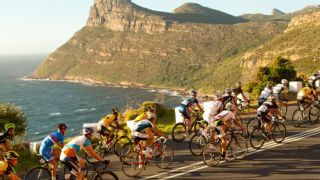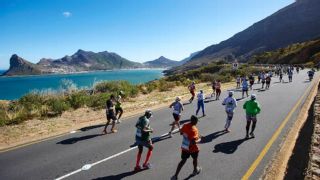|
With a perfect storm of major sports events bearing down on drought-stricken Cape Town over the next two months, plenty of creative planning has been required to keep the show on the road(s). South Africa's second city is facing a water crisis of historic proportions -- with Day Zero, the much-feared moment when the taps run dry, currently scheduled for mid-May -- and questions have rightly been asked about how the city's jam-packed endurance events schedule can continue. Against a backdrop of harsh Level 6B restrictions that limit water usage to 50 litres per person per day, and with the spectre of #DayZero looming large, the timing couldn't have been worse for a long list of flagship events. Endurance athletes alone will flood the city, with The Cape Town Cycle Tour, the Two Oceans Marathon, the Cape Epic, the UCI mountain bike World Cup, and the Cape Roleur cycling stage race all packed into the pre-May months. But tourism is a R40 billion (just over $3 billion) industry in the Western Cape, supporting 320 000 direct and indirect jobs. According to Wesgro, the province's trade and tourism development agency, in just 10 days in March, two events -- the Cape Town Cycle Tour and the Two Oceans Marathon -- generate close to R1.2 billion for the region's economy. Numbers like that are far too big to ignore. "If you want a disaster within a disaster, then you compound a water crisis by job losses and an economic downtown while you're at it," City of Cape Town councillor JP Smith tells KweséESPN. "A water management plan is now a requirement for the planning of all large events." The message is clear: Cape Town is open for business, but it's not business as usual. In the midst of such a punishing drought, that would be morally and practically indefensible. Instead, the same innovative flair that made these Cape-based events so successful in the first place is being deployed to take hundreds of thousands of participants, fans, and spectators completely off the municipal water supply grid.  The Cape Town Cycle Tour, on March 11, is pioneering the way. Having negotiated sweltering temperatures, veld fires, and 100km/hour winds in previous editions, the world's biggest timed bike race (35 000 cyclists on a spectacular 109km route) is no stranger to crisis management. Working closely with their hydration partners, all race-day supplies of drinking water, Coca-Cola, and Powerade will be sourced or manufactured either from local spring water or from another, non-drought-affected province. There will be no showers at the finish line, hand sanitisers will replace wash basins, and desalinated water will be used for caterers' dishwashing needs. More impressively, the Cycle Tour has committed to offsetting the water used by its out-of-town participants (and those who might travel with them) by sourcing two million litres of potable water from a municipality whose dams are overflowing, transporting it to Cape Town and injecting it back into the municipal water system. Erasing the Cycle Tour's entire water footprint won't be cheap. Not only will the process be independently audited, it will also cost the not-for-profit race organisers around R1 million, or 10% of the surplus funds they channel to charities. "Our thinking was that it's better to invest in ensuring that the water goes back into the system and still distribute R10-million to charity than cancel the race and distribute no money to charity," CTCT director David Bellairs tells KweséESPN. "But the most important thing is that the Cape Town Cycle Tour does not bring Day Zero forward by even a single minute."  Fielding nearly 30 000 runners across four events (the ultra-marathon, half-marathon, trail run and fun run), the Two Oceans Marathon is not far behind the Cycle Tour in terms of size, but its race-day consumption of about 90 000 litres is significantly less than the CTCT's 350 000 litres. The Two Oceans, on March 31, will also not draw from municipal water for its race needs and participants are being encouraged to run with hydration packs, as well as to bin or pocket their empty water sachets as part of an ongoing plastic recycling programme. Although the Cape Epic, over its eight days of racing in the Western Cape, will be visiting towns much less burdened by water restrictions, race organisers are determined to apply Cape Town's stringent water guidelines to their entire event. The Epic, raced from 18 to 25 March this year, has always used non-potable water for its showers in the race village, but this year the shower water will be recycled back into the bike wash bays as the event aims to cut its consumption by 40%. Arabella Wines, near the small town of Robertson, who are the hosts of the Epic race village for the first three nights, have been collecting water for a year and have stockpiled 400 000 litres. In addition, Swellendam municipality has offered to supply enough potable and non-potable water for the entire race so, much like the Cape Town Cycle Tour, the Epic organisers will be trucking that water to a storage facility selected by the City of Cape Town.  Even international events like the UCI mountain bike World Cup, which comes to the Cape for the first time, will be bound by local restrictions. The event will also be water-neutral in terms of its footprint: the bike wash for the world's best riders will be in the form of non-potable water in 5L buckets (a minimum of two bikes washed per bucket). The race organisers had hoped that locals would flock to Stellenbosch to ride the World Cup track for themselves, but the course is closed a full month before race day on 10 March, to minimise the water needed to reshape and repair any wear and tear on the dirt track. What has universally focused the minds of Cape Town's event organisers, and which should provide some perspective to Capetonians growing increasingly intolerant of any and all water wastage, are a couple of statistics offered by Wesgro. First, international tourists comprise just 1% of the Cape Town population. Add in domestic tourists, and the number climbs to 2.4%. Clearly, then, tourists' water use is completely dwarfed by their economic contribution. More importantly -- and this should give South Africa's broader tourism industry some pause for thought -- once a destination drops off a tourist's must-see list, it takes up to five years to make it back onto the radar.  Or, as Wesgro CEO Tim Harris puts it: "You can't separate the costs of the drought and the benefits of tourism into regions. There are very few itineraries to South Africa that don't include Cape Town." Clint Hendricks, the defending champion of the Cape Town Cycle Tour, is equally clear-eyed: "We need big events like this in South Africa. I applaud the organisers for coming up with solutions to keep the event running." And then adds: "Luckily our Team BCX has a water sponsor. Maybe they can help us out!" For the rest of those who are travelling to the Western Cape -- unless you're heading to areas unaffected by the drought, like the beautiful Overberg or the famous Garden Route -- some old travel advice still rings true: When in Rome... save like a local.
|

